 | (part one) Written and researched by Margaret [nee knight] Sypniewska, Bachelor of Fine Arts 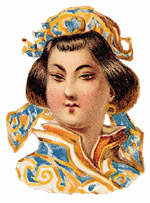 |
 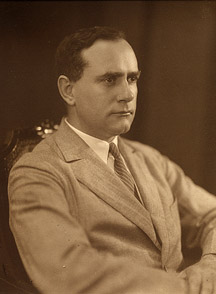 
born September 29, 1887 in Auchtermuchty, Scotland Alex was pronounced legally dead on February 13, 1945.
This page is dedicated to the memory of the late Alexander Malcolm, Jr.
Alexander was an engineer in China (Malcolm & Co. Ltd.), a man who had a dream. In Stella Dong's book, Shanghai 1842-1949: The Rise and Fall of a Decadent City she states: "In Shanghai's prime no city in the Orient, or the world for that matter, could compare with it." "Shanghai was half Oriental, half Occidental; half land, half water; neither a colony nor wholly belonging to China."

on the East China Sea
Shanghai was a dream come true to many people. It offered monetary benefits for those who were willing to sacrifice. Shanghai literally meant "above the sea," but it came to mean an unscrupulous means to provide sailors for voyages to the Orient or to put by trickery into an undesirable position. "He was Shanghai'd" is still used in our conversations.
In 1842, "the red-haired barbarians" (what the Chinese called the British), first ransomed Shanghai's riches at three million dollars. On August 29, 1842, the Treaty of Nanking asked the payment of twenty-one (21) million silver dollars for the cessation of Hong Kong. Besides cessation, they wanted low tariffs on foreign goods, and the opening of five Chinese ports to foreign trade and residence. Soon after, the French and the United States made similar treaties with Peking, Chinese officials. The British being first and foremost had the upper hand. Unfortunately, they used opium as their weapon to subjugate the Chinese and thus making them dependant on their poppy crop.
The British wanted tea and silk, so they traded opium and turned millions of Chinese into addicts. The Ching government had banned opium smoking and by 1880 it could not be sold. However, black market trading took over, and opium was sold to the Chinese gentry and leisure class under the guise of night and secret meeting places. In 1839, the idea of dealing drugs did not hold the same stigma it does today. Two Scotsmen, William Jardine and James Matheson, were leaders in bringing opium to China. Their firm was called Jardine, Matheson, and Company. William Jardine was a British East India Company surgeon. James Matheson was the son of a Baronet.
Shanghai was built with Oriental sweat and labor, for Occidental gains. When the British merchants arrived in 1843, they were given 140 acres of muddy foreshore north of the walled city of Shanghai. They then began to drive pilings into the watery terrain with concrete reinforcements to literally build their city on the water. At high tide this was especially necessary. Shanghai had no typhoons and was more temperate than other Chinese cities. The summers in Shanghai were extremely hot and humid. The heat alone made foreigners suffer, and they changed their clothes three times a day. It was soon discovered that there were many challenges to be overcome in this port. Diseases were prevalent: athlete's foot, ringworm, skin problems, and parasites of all sorts. The water was septic and needed to be boiled and treated with alum before anyone could drink or take a bath.
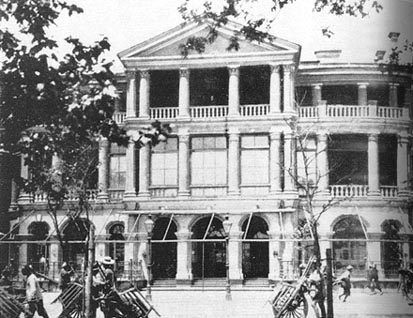
The Shanghai Club was opened only to Occidental men, and it boosted the "longest bar in the world."
Chinese Shanghai had existed since the tenth (10th) century and before that it was a fishing village. It was located fourteen (14) miles near the mouth of the Yangtze River which made it an excellent location for transporting goods to inland China. The wall was built around the city to protect their port from pirates.
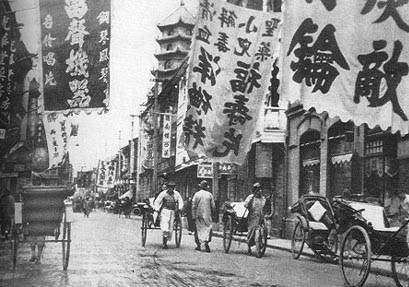
Nanking Road
June 12, 1915 - Canton, China, has severe flooding - 100,000 perish.
The Soong Family:
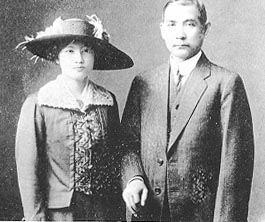
The Soongs were a parvenu Shanghai family. Charlie Jones Soong/Soong Yau Ju was born, in 1875, to impoverished parents on South China's Haninan Island. Yau Ju Soong was adopted by an "uncle" and taken to Boston, Massachusetts, U.S.A., to labor in a tea and silk shop. Yau Ju ran away to seek an education. First, he was ship's boy under a Captain Gabrialson, the master of the Bostonian ship on which Soong had stowed away. It was Gabrialson who introduced "Charlie" to evangelical religion. He was later baptized Charles James Soong. Charles Jones Soong died May 3, 1918 (see below). Soong Yau Ju was the father of am important family. He was been educated, in the United States, in the American fundamentalist Bible culture. He returned to Shanghai as a Southern Methodist. He was to be a missionary, but made more money printing bibles.
He became a multi-millionaire as a merchant, aided, in part, by his adoptive American father, tobacco magnate, Julian S. Carr, of Durham, North Carolina. Back in Shanghai, Charles married the daughter of one of China's most powerful Tongs. He fathered six children, the most famous were his three daughters--Ai-ling, Ching-ling and Mei-ling. He had a sons: T.V., T.L., and T.A.
The girls attended Methodist Mctyeire School in Yuyuan Lu, and studied at Wesleyan College for Women in the United States. T.V., their brother, went to Harvard and Columbia. Using Anglicized initials, for the boys, rather than one's Chinese name was considered fashionable in Shanghai.
A frequent visitor to the Soong family's home was Sun Yat-sen. Sun Yat-sen wanted to marry Ching-ling Soong, even though he was close to the same age as her father, and was already married to another woman (see photo above).
Sun Yat-sen was the man who brought the Qing Dynasty (or Manchus) to an end. Sun was born to a peasant family near Macau. He studied medicine in Guangzhou and Hong Kong. Between 1918 and 1924 he lived at 7 Xiangshan Lu, in Shanghai, with his wife Ching-ling Soong. He died in 1924 in Beijing. His widow then lived at 1843 Huanihai Zhong Lu. Madame Soong died in 1981. She is buried next to her parents in their plot in the Wanguo Cemetary.

Wife of Chiang Kai-shek Their Home
Ai-Ling married Dr. H. H. Kung, a member of a Shanghai banking family and a descendant of Confucius . Dr. King became the Minister of Finance in the Guomindang government. Their extended family became a major financial force in New York, San Francisco, and Dallas, Texas.
The Soongs were a upwardly mobile family. Eventually Mei-Ling would be "first Lady" of China, when she married Chaing Kai-shek 1927. Her husband-to-be was 13 years older than her. He divorced his first wife, and agreed to convert to Methodism to win Mei-Ling Soong's hand.
Chiang Kai-shek's son by his first wife, Chiang Ching-kuo, was later made leader of Taiwan.
It was said that Mei-Ling Soong was a greedy woman, and she amassed a huge fortune by manipulating government bonds, speculating in silver and currency, and siphoning American aid to China, whenever possible (Johnson, Nancy.Shanghai Hong Kong: Odyssey Publications, Ltd.1999). By the time the Communists took power they had millions of dollars in United States banks.
A saying goes:
"Ai-ling loved money, Mei-ling loved power, and Ching-ling loved China."
This was because Ching-Ling was the only sister to remain in China.
A photograph of the wedding of Chiang Kai-shek and Mei-ling Soong follow in this account (part 2).
Charles Soong's three biological sons were among the richest people in the world. T.V. Soong, was not only prime minister of nationalist China, but later became a millionaire by taking advantage of an artificially controlled government currency exchange rate. Before, during, and after World War II, T.V. Soong converted U.S. foreign aid money and Christian missionary, charitable contributions, primarily from the United States, into millions of dollars on the Chinese foreign currency market--at a profit as high as 2000:1.
Charlie Soong's other two sons, T.L. and T.A. Soong began family finance dynasties in New York and San Francisco, respectively.
It was rumored that Charlie Soong was murdered by a slow poison. (Bengtson, David. Past Lives of Famous People: Journeys of the Soul. Woodside, CA.:Bluestar Communications, 1997).
May 14, 1916 - Constance Stevens sails from England, on the Morea, and reaches Shanghai by September. She is there to teach in a public girl's school. She has signed a three-year contract to teach kindergarten. She attends a party, on a houseboat owned by a teacher named Rhonwyn Rees. This is where Alexander and Constance first meet.
August 29, 1916 - Chinese Streamer Hsin Yu sinks off the Chinese coast - 1,000 die.
1917-1918 - the Chinese plague (pneumonic) strikes. 16,000 people get infected, and there are scattered cases in Hong Kong.
March 1918 - an influenza epidemic strikes in Peking. By May 1918 it is in Shanghai. 404 people die from this epidemic.
May 3, 1919, Alexander Malcolm, Jr. and Constance Winifred Stevens are married at the British Consulate (in the morning) and at Shanghai Cathedral (in the afternoon), satisfying both British and Chinese law. Since Alex could not get time-off to travel at this stage in his career, they went to their home at 23 Tifeng Road.
In northern China, famine kills 500,000 people. December 16, 1920 an earthquake in Kansu, China kills 80,000 people.
Luckily, Louis Pasteur had developed a vaccine. In 1871, 332 per million died of typhoid. By 1991, only 36 per million died.
In 1923, Alexander has contract with the Canton Waterworks for three years. After this he planned to go into semi-retirement. He had plans to remain in England for most of these year, and spend about three months in the Orient.
utm_campaign=shareaholic&utm_medium=facebook&utm_source=socialnetwork Shanghai Page 2 ..... Shanghai Page 3....
Home
Email Margaret: Maggie9731@aol.com"> Margaret This page was last updated on July 16, 2017
 |